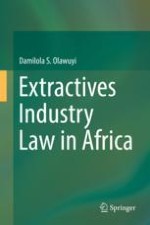2018 | OriginalPaper | Chapter
7. Legal Rights and Interests in Resource Extraction
Author : Damilola S. Olawuyi
Published in: Extractives Industry Law in Africa
Publisher: Springer International Publishing
Activate our intelligent search to find suitable subject content or patents.
Select sections of text to find matching patents with Artificial Intelligence. powered by
Select sections of text to find additional relevant content using AI-assisted search. powered by
